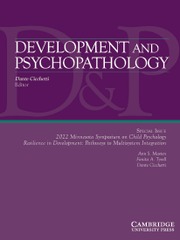Crossref Citations
This article has been cited by the following publications. This list is generated based on data provided by
Crossref.
Pace, Ugo
D'Urso, Giulio
and
Zappulla, Carla
2018.
Adolescent Effortful Control as Moderator of Father's Psychological Control in Externalizing Problems: A Longitudinal Study.
The Journal of Psychology,
Vol. 152,
Issue. 3,
p.
164.
Regan, Timothy
Harris, Bethany
and
Fields, Sherecce A.
2019.
Are relationships between impulsivity and depressive symptoms in adolescents sex-dependent?.
Heliyon,
Vol. 5,
Issue. 10,
p.
e02696.
Taylor, Zoe E.
Evich, Carly D.
Marceau, Kristine
Nair, Nayantara
and
Jones, Blake L.
2019.
Associations Between Effortful Control, Cortisol Awakening Response, and Depressive Problems in Latino Preadolescents.
The Journal of Early Adolescence,
Vol. 39,
Issue. 7,
p.
1050.
Wang, Frances L.
Eisenberg, Nancy
and
Spinrad, Tracy L.
2019.
Bifactor model of effortful control and impulsivity and their prospective prediction of ego resiliency.
Journal of Personality,
Vol. 87,
Issue. 5,
p.
919.
Gonzales-Backen, Melinda
2019.
Parenting Practices and Adjustment Profiles among Latino Youth in Rural Areas of the United States.
Social Sciences,
Vol. 8,
Issue. 6,
p.
184.
Moeijes, Janet
Van Busschbach, Jooske T.
Lockhart, Krista L.
Bosscher, Ruud J.
and
Twisk, Jos W. R.
2019.
Characteristics of sports participation and psychosocial health in children: Results of a cross‐sectional study.
European Journal of Sport Science,
Vol. 19,
Issue. 3,
p.
365.
Dollar, Jessica M.
and
Calkins, Susan D.
2019.
Handbook of Emotional Development.
p.
199.
Pace, Ugo
D'Urso, Giulio
and
Zappulla, Carla
2019.
Internalizing problems as a mediator in the relationship between low effortful control and internet abuse in adolescence: A three-wave longitudinal study.
Computers in Human Behavior,
Vol. 92,
Issue. ,
p.
47.
V. Grebneva, Valentina
Ju. Kovtunenko, Alexey
B. Tarabaeva, Victoria
and
V. Moskalenko, Svetlana
2019.
THE PREVAILING MECHANISMS OF PSYCHOLOGICAL PROTECTION AT PERSONS WITH DIFFERENT DOMINANCE OF TEMPERAMENT.
Humanities & Social Sciences Reviews,
Vol. 7,
Issue. 5,
p.
965.
Bai, Lu
Liu, Yan
and
Xiang, Shiyuan
2020.
Associations between Parental Psychological Control and Externalizing Problems: The Roles of Need Frustration and Self-control.
Journal of Child and Family Studies,
Vol. 29,
Issue. 11,
p.
3071.
Olivier, Elizabeth
Morin, Alexandre J. S.
Langlois, Jessika
Tardif-Grenier, Kristel
and
Archambault, Isabelle
2020.
Internalizing and Externalizing Behavior Problems and Student Engagement in Elementary and Secondary School Students.
Journal of Youth and Adolescence,
Vol. 49,
Issue. 11,
p.
2327.
Martin‐Storey, Alexa
Lemelin, Jean‐Pascal
Temcheff, Caroline
and
Déry, Michèle
2020.
Exploring childhood temperament as a moderator of the association between adolescent sexual minority status and internalizing and externalizing behavior problems.
Journal of Adolescence,
Vol. 84,
Issue. 1,
p.
190.
Cavelti, Marialuisa
Thompson, Katherine
Betts, Jennifer
Fowler, Claire
Luebbers, Stefan
Cotton, Sue M.
and
Chanen, Andrew M.
2021.
Borderline Personality Disorder Diagnosis and Symptoms in Outpatient Youth as Risk Factors for Criminal Offenses and Interpersonal Violence.
Journal of Personality Disorders,
Vol. 35,
Issue. Supplement C,
p.
23.
Shewark, Elizabeth A.
Ramos, Amanda M.
Liu, Chang
Ganiban, Jody M.
Fosco, Gregory
Shaw, Daniel S.
Reiss, David
Natsuaki, Misaki N.
Leve, Leslie D.
and
Neiderhiser, Jenae M.
2021.
The role of child negative emotionality in parenting and child adjustment: Gene–environment interplay.
Journal of Child Psychology and Psychiatry,
Vol. 62,
Issue. 12,
p.
1453.
Peng, Yuan
Yang, Xiaohui
and
Wang, Zhenhong
2021.
Parental Marital Conflict and Growth in Adolescents’ Externalizing Problems: the Role of Respiratory Sinus Arrhythmia.
Journal of Psychopathology and Behavioral Assessment,
Vol. 43,
Issue. 3,
p.
518.
Galehouse, Pamela
and
Foley, Marie
2021.
Child and Adolescent Behavioral Health.
p.
23.
Liu, Ran
Calkins, Susan D.
and
Bell, Martha Ann
2021.
Frontal EEG asymmetry moderates the associations between negative temperament and behavioral problems during childhood.
Development and Psychopathology,
Vol. 33,
Issue. 3,
p.
1016.
Feldman, Julia S.
and
Olson, Sheryl L.
2021.
Supportive Maternal and Paternal Caregiving and the Children’s Emerging Effortful Control Abilities.
Journal of Child and Family Studies,
Vol. 30,
Issue. 4,
p.
894.
Fitzpatrick, Caroline
Harvey, Elizabeth
Cristini, Emma
Laurent, Angélique
Lemelin, Jean-Pascal
and
Garon-Carrier, Gabrielle
2022.
Is the Association Between Early Childhood Screen Media Use and Effortful Control Bidirectional? A Prospective Study During the COVID-19 Pandemic.
Frontiers in Psychology,
Vol. 13,
Issue. ,
伍, 越
2022.
Research Progress and Prospect of Interparental Conflict and Adolescent Behavioral Problems.
Advances in Psychology,
Vol. 12,
Issue. 02,
p.
537.

